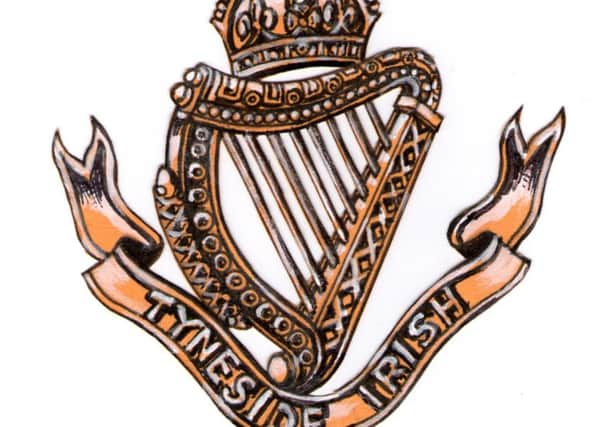Many in the Tyneside Irish belied that name


A wreath of shamrock was placed at the memorial at Eldon Square in Newcastle while the Thomas Moore tune The Minstrel Boy was played on the Irish pipes.
It was, of course, St Patrick’s Day, and the service was in honour of the many men who fought with the Tyneside Irish battalions of the Northumberland Fusiliers in the First World War.
Advertisement
Hide AdAdvertisement
Hide AdLike many young men around the country, they joined in their thousands in the first flush of war as they heeded Herbert Kitchener’s call for help.
Local businessmen with Irish connections asked, and received, permission from the War Office to set up an Irish battalion from the Tyneside area, and they were eventually to attract enough men for four battalions.
On St Patrick’s Day in 1916, their commanding officer gave every man in the battalions a sprig of shamrock to celebrate the patron saint of Ireland.
Many of those men were to die some months later on the slopes around the heavily-fortified German positions at the small village of La Boisselle on July 1, the opening day of the Battle of the Somme.
Advertisement
Hide AdAdvertisement
Hide AdA parade and service on St Patrick’s Day was first taken up shortly after the end of the war by the veterans themselves, but as the years went by and those veterans began to dwindle in number, the parade petered out.
That tradition was recommenced six years ago by members of the Tyneside Irish Centre at Gallowgate in Newcastle and has grown every year. It is now a prominent feature of the St Patrick’s Day events held in the city.
In the presence of the mayor of Newcastle and members of the Tyneside Scottish Association, a shamrock was given to the veterans of the Northumberland Fusiliers’ Association and, in a fitting touch, to representatives of some of the other nations who also fought in the Great War, including Germany.
Who where the Tyneside Irish, though?
Research by John Sheen in his excellent book Tyneside Irish revealed that although most of the men were from this area and had Irish roots, not all were of Irish descent or from Tyneside. Indeed, the battalions’ two Victoria Cross recipients came from Lancashire and Yorkshire.
Advertisement
Hide AdAdvertisement
Hide AdDismissed as ‘slum birds’ by a general from an elite Irish division, they drilled and trained in camps in the shadow of Alnwick Castle on land donated by the duke of Northumberland.
War came closer with a move south to the training grounds of the British Army on Salisbury Plain. Regular meals and regular training outdoors had honed their fitness, and so it was off to France after that.
Their moment came at 7.30am on July 1, 1916, a sunny Saturday morning, as they clambered over the parapets of their trenches into battle for the first time, among them three Wallsend lads, Privates John William Pallace and
James Purcell, and Sergeant Wallace Lloyd.
Many heard the Irish pipes that morning. The piper was to recount years later that he played The Minstrel Boy because he thought its words appropriate.
Advertisement
Hide AdAdvertisement
Hide Ad“The minstrel boy to the war is gone. In the ranks of death, you’ll find him. His father’s sword he has girded on. And his wild harp slung behind him,” it goes.
They were cut down in swathes by murderous German machine-gun fire.
Whole battalions were decimated, including those of the Tyneside Irish and Tyneside Scottish.
One veteran reflected years later: “It took two years to train them, and two minutes to kill them.”
Advertisement
Hide AdAdvertisement
Hide AdThese and other men killed in that great conflict are being researched by volunteers at the Northumbria World War One Commemoration Project, and they estimate that some 5,000 men from the borough of North Tyneside perished.
For details, email [email protected]
More than 1,800 casualties have already been researched by an earlier project centred on the old borough of Tynemouth and are now on a free and accessible database at www.northumbriaworldwarone.co.uk
The casualties are researched by consulting Commonwealth War Graves Commission records, the National Archives at Kew, newspaper accounts and names on the many memorials and cemeteries dotted around the borough, as well as diaries and letters from family relatives.